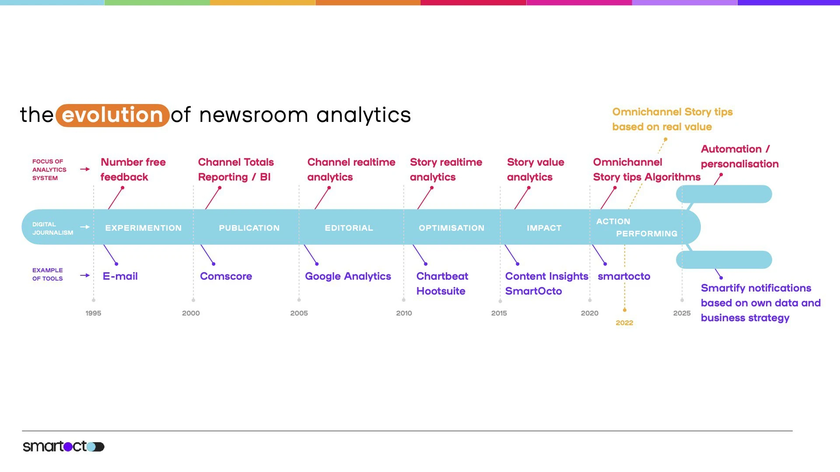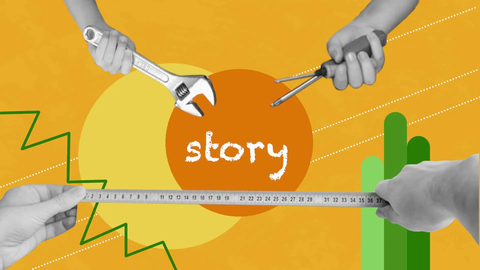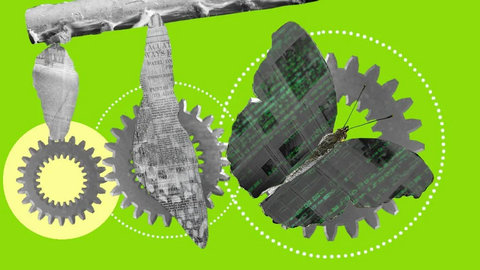Ah, analytics. The word alone is enough to make some cower in fear and others rub their hands in anticipation. Regardless of how you personally feel about it, it is a pretty useful tool for any kind of business - if you use the right kind of analytics. And chances are you can find something specific for your organisation.
Why you should choose editorial over generic analytics
Aug. 20, 2021 by Jacqueline Woudstra

Getting data is not the issue, but using it is
What do you expect from it and who will be working with it? That's precisely where the challenge lies: from the early days, server logs and web statistics could be understood by the 'techy' types within organisations, but not so much the content-creating folks. More sophisticated analytics were developed to change that, but it still doesn't mean that data is now easy to interpret for everyone. And in the flood of data that is currently available, deciding what data actually matters is paramount.
We all need data. But what do you do with it?
The story of analytics began with 'hits', or what we today would call pageviews. And even today, that is still the most current statistic. Valuable information if you're trying to increase your reach, or build a large audience for eyeballs. But what does that pageview actually tell you? It tells you that people visited the page. Nothing more, nothing less. There's no impact value attached to that pageview. Sure, you can check scroll depth and visit length, but that still doesn't tell you if the reader appreciated the story.
Wouldn't you rather know if the people reading your articles are frequent visitors, or if they went on to visit more pages (or even hit that 'subscription' button after reading that article)?
Fortunately, there's editorial analytics tools, like smartocto, that offer this type of information right up. But with those insights alone you're still not there yet. Now you need to know what to do with it. In other words: you have to make the insights actionable. (We have some great ideas for that, too! You can rewatch the webinar we did on this topic or read our blog "Making content analytics data actionable".)
Job-specific analytics are needed
The data needs to align with your goals, or it will not help you to measure them. That's why editors need different data than journalists, marketers, and data analysts. It matters if you're concerned with day-to-day successes, or long-term trends. Do you need the data to optimise right now or evaluate later? Job descriptions change alongside the progression of editorial analytics and the online publishing industry as a whole.
Analytics tools are still evolving

In the early days, analytics would tell you what happened yesterday. In time, they evolved to tell you what's happening right now. The next step is predicting what will come tomorrow.
Right now, dashboards with real time data are still special. People are still getting used to having data on the workfloor and those dashboards provide them with just enough information. But what happens when those become a commodity? When everybody has embraced the value of real time data and starts to take it for granted, demands on data and analytics tools will increase. We're already seeing this with the adoption of AI and robotics in more and more industries. And at smartocto as well, we've become very interested in the benefits and possibilities of machine learning. Without it, we wouldn't have been able to create our actionable user needs notifications.
The role of robotics in journalism right now is primarily two things: interpretation of data and creating simple news stories and social media posts. Many people still fear that AI could take over jobs if it starts writing, but it can really be extremely helpful. The online landscape is changing and becoming more demanding.
If robotic writing takes over the predictable content creation and routine stories, the flesh and blood journalists can focus on the pieces that attract a larger audience and truly set the brand apart. The technology is not here to steal your creative process or disrupt your editorial flow. If anything, it will free your hands to do more of that. But in order to be able to really embrace the opportunities of technology, a culture shift is needed in the newsroom.
The non-disruptive alert to boost performance
AI's support in the interpretation of data is useful if you don't want to look at dashboards all day. You only want to know when things happen that demand attention or that are out of the ordinary, right? The deep-dive analytics reports can be saved for once a week or month, but in the day-to-day work environment you don't want to be concerned with or disrupted by data unless it can immediately benefit you.
What can you do right now to boost the performance of your latest story - that's all you need to know. That's why our notifications are based on and supportive of your own business model and goals. Unless there's an action you can take to support your overall strategy, you won't hear from us. A notification layer in data analytics, that helps you interpret data and take action, will be a new requirement for UX.
Prediction in analytics takes this one step further.
As soon as you hit 'publish', the system notices a new story. Based on the selected tags (author, topic, user need) and other factors such as time of day, the system quickly checks the performance of similar articles and advises you on the best course of action based on that data. You see, smartocto is setting you up for success every step of the way, and the more you publish, the more accurate the algorithm will become.
The final step in analytics evolution: actionable, smart, automated
What's left after AI and robotics, job-specific analytics and predictions have been added to an analytics system? What could be the next step? To summarise, our ideal content analytics tool answers to these criteria:
Actionable
You don't just need data, you need to know how to act on it. Alerts and notifications that tell you when and how to spring into action are what you need.
Great data delivery
Not everyone is a fan of numbers, and complicated graphs and tables may be challenging to read and interpret. That's why the data needs to be presented attractively and in a clear way. Customisable dashboards that give an overview of the most important metrics are great. Also, a daily summary digest of the most important things that happened yesterday and the most important actions for today are very helpful to keep a grip on your data and stay in control of your content strategy.
Timing
You need the right data at the right time for it to be truly helpful. Suggestions in the form of a notification for improvement when you've just published a piece can help boost its performance when it's still 'hot off the press'. Suggestions for a follow-up when people are still talking about it on Facebook help maintain momentum. And best of all, these little nudges that show benefit right away are great to help alleviate fears and doubts of those who are still data-resistant.
Smart
A truly smart analytics tool will ask you "it's this time of the day, would you like to do this task now?". Because it learns from past actions, determines the best time to do certain things and sends you helpful reminders for routine tasks. But it also shows you new possibilities, tips for improvement that help you come up with creative ideas, and different ways to go about something. In short, it should be a tool that assists you in daily tasks and responsibilities but still leaves room for interpretation. And that's what we are currently creating.
A smart system anybody can use, regardless of the data collection tool you're already using. It's called Smartify: the next step in editorial analytics that can make any system smart. It's a set of features that can be connected to any data source. It collects the data, interprets it, makes calculations based on your own strategy and goals and delivers the insights you need to succeed. That could be in the form of a custom dashboard, actionable notifications or daily digests of your most important or notable insights and actions.
We truly believe that this is the future of analytics, and we'd love to Smartify your system. If you're ready for this next step, you'll know where to find us.
you may also like...
Optimising story performance with the right editorial data
Public broadcaster Omroep Zeeland is discovering a new journalistic approach to stories and follow-ups. Smartocto data and notifications help them reach their goals.

How newsrooms can transform into editorial action centres
Online publishers and newsrooms need a data-informed approach to create relevant content, and answer to the needs of a new audience of digital natives.
